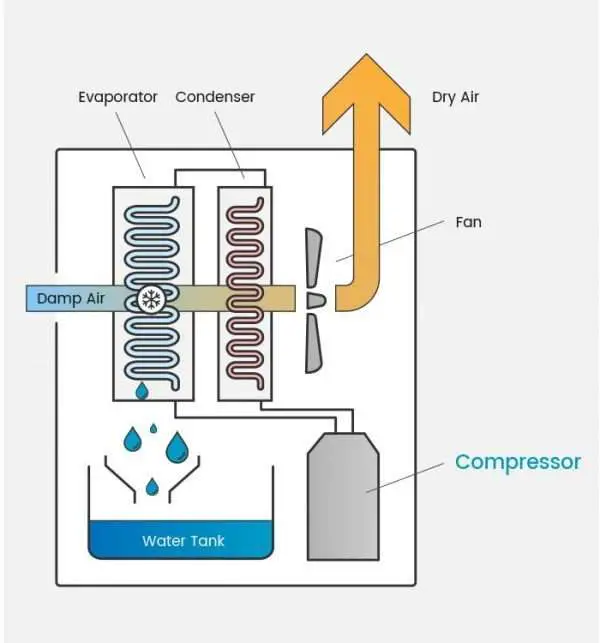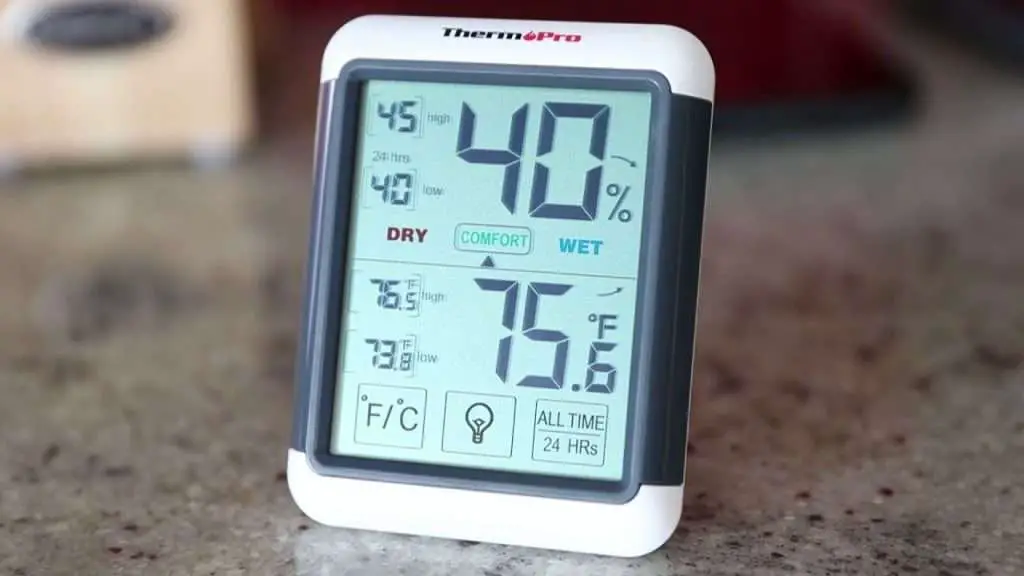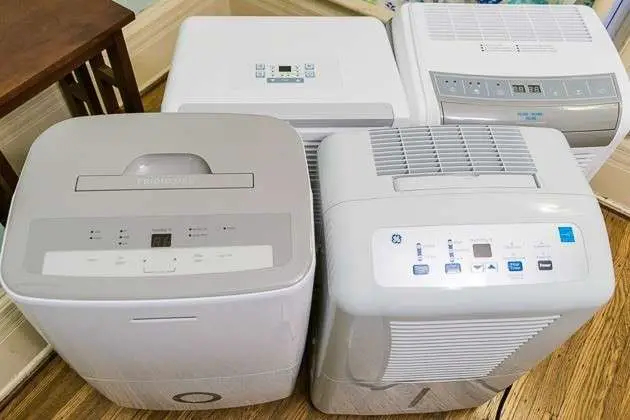
A Typical Home Dehumidifier
The presence of damp, mold and high levels of humidity and condensation can affect any building, whether your home, an office or even a shed at the bottom of your garden.
The common factor between all of these unwanted issues is the same: too much moisture in the air and a distinct lack of ventilation. As you might expect, the solution for this air quality problem is also the same: remove the source of excess moisture and find a way to increase air flow.
What is a Dehumidifier?
The most common way to reduce the amount of water in the air and increase airflow with the least amount of effort is by using a dehumidifier. A dehumidifier is simply designed to extract moisture from the air before then blowing this dry air around the room it is placed in.
There are many different types of dehumidifier in existence, all of which are designed to do exactly the same thing. The purpose of this guide is to tell you exactly how they work and educate you on their use so that you can find the best dehumidifier for your home.
How Does a Dehumidifier Work?
You’re now aware of what a dehumidifier is designed to do, but how do they complete this task? The process may sound complicated, but it is actually very simple, and we guarantee that you will own a variety of appliances that work in much the same way.
All dehumidifiers work in one of two ways. The first is via refrigeration (cooling air to remove moisture using similar technology to a refrigerator or an air conditioner) and the second is via absorption / adsorption (where moisture is absorbed into or adsorbed onto a drying material and then removed).

Refrigeration
- Warm, moist air is sucked into the dehumidifier through a grille via an electric fan.
- This warm air is passed over freezing cold pipes which are filled with refrigerant.
- As the air cools, the moisture it contains returns to water droplets which drip onto these pipes where it is then collected within a reservoir.
- Cool dry air then passes over a heating element where it is warmed back up to its original temperature.
- This warm dry is then expelled out of the dehumidifier back into the atmosphere via another fan.
Absorption / Adsorption
- Warm, moist air is sucked into the dehumidifier through a grille or a duct.
- This warm air is immediately passed over a large rotating wheel which contains a material that can absorb water.
- A heating element sits below this wheel which dries out the absorptive material within the water wheel.
- Dry air is expelled out of the dehumidifier and back into the atmosphere.
Refrigerant models are the standard and are sometimes referred to as compressor dehumidifiers. Absorption models are usually referred to as desiccant dehumidifiers.
Compressor dehumidifiers are perfect for the interior of your home whereas desiccant dehumidifiers are better suited to colder environment such as a garage or unheated storage spaces. We go into further detail in our compressor vs desiccant dehumidifier guide.
Further reading: Humidifiers vs Dehumidifiers
What are the Benefits of a Dehumidifier?
The benefits are numerous. The most obvious one is that drier air will prevent mold growth. Other benefits include improving respiratory health conditions and reducing the prevalence of allergies. Our article covering the benefits of dehumidifiers goes into more detail.
What Is a Commercial Dehumidifier?
We have previously mentioned that dehumidifiers utilize one of two different types of technology; compressor or desiccant. But even within these two categories there are a range of models which are suited to different applications.
Dehumidifiers which are suited to domestic use are readily available from most retailers, but commercial dehumidifiers which are suited to more heavy duty applications are sometimes only available from specialist retailers.
To put it simply, commercial dehumidifiers are designed to be run for extended periods of time whilst performing at a high level. This could be within a commercial building that has experienced water damage or within a house that is being built which needs to be dried out once the doors and windows have been installed.
Unless you are remediating significant water damage, it is unlikely that you will require a dehumidifier of this category for your home.
How Do I know if I Need a Dehumidifier?
If the air within your home contains large amounts of water, you will notice that mold will begin to form on your furniture and clothes. The air might also feel ‘sticky’ or even ‘wet’.
We have created a great article which covers the tell-tale signs in greater detail.
How Do I Find Out the Level of Humidity?
If you’re looking for a specific indoor humidity reading, you will need to use a hygrometer. This will provide you with both the indoor air temperature as well as the level of relative humidity in percentage terms.
Our article on monitoring indoor humidity explains further.

Is a Bigger Dehumidifier Better?
Your dehumidifier should be sized for the room you will use it in. What is important to know is that a bigger dehumidifier will always dry air faster. This will mean that a larger dehumidifier is always more efficient and should be favored over a small model.
A 70 pint dehumidifier is often the best choice for most homeowners. 50 pint dehumidifiers and 30 pint dehumidifiers are also available and might make a suitable option for smaller environments.
It is also possible to find 40 pint and 60 pint models but they are much rarer.
How Do I Dispose Of the Water Collected By the Dehumidifier?
Your options are either to use the integrated water bucket or to instead attach a section of hose. This hose can then be routed out of a nearby window or into a floor drain or sink.
There are several ways to facilitate water drainage which we have covered in detail.
Can a Dehumidifier Kill Mold?
This is a question we receive often. Mold grows much faster in humid environments, and so removing as much moisture and humidity as possible will make it harder for mold to form.
If your home is already suffering from a mold outbreak, using a dehumidifier will prevent it from spreading further which will then allow you to clean it off any surfaces it has settled on. More information can be found in our dehumidifier mold prevention article.
Can a Dehumidifier Be Used In the Bathroom?
Yes it can, and it is even recommended. A bathroom dehumidifier is designed to extract the moisture produced whilst showering and bathing and will make your bathroom far more pleasant to use.
If your bathroom has an extraction fan, your bathroom dehumidifier will work even faster to remove excess moisture and humidity.
Do I Need a Special Dehumidifier for the Garage?
Any dehumidifier can be used in a garage. If you live in a cold climate, be sure to buy a dehumidifier that will work in low temperatures.
Take a look at our garage dehumidifier guide for more information.
Can a Dehumidifier Be Used in a Gun Safe?
Dehumidifiers for gun safes are different to regular models. They are usually a bar heater which is designed to heat the interior of a safe, lowering humidity in the process.
Can a Dehumidifier Be Used in Any Room of a House?
Yes they can. Bedroom dehumidifiers are great for dehumidifying the room you sleep in and mini dehumidifiers are great for use in closets and other confined spaces.
If you live in an apartment, dehumidifiers for apartments are compact and lightweight for ease of use.
Can a Dehumidifier Be Used in a Grow Tent?
Grow tents have become increasingly popular over the years, but one issue many encounter is controlling the level of humidity inside the tent.
For this purpose, we recommend a grow tent dehumidifier. They are small and efficient and are great for optimizing humidity inside any grow tent.
Do I Need a Certain Type of Dehumidifier for My Crawl Space?
Crawl spaces often suffer from damp. Damp can lead to wood rot and a variety of unwanted structural issues which is why the use of a crawl space dehumidifier is desirable.
A dehumidifier designed for crawl space use is the best option as they are more powerful and are designed to operate in low temperatures, but you can also use a smaller model if required.

Dehumidifier Manufacturers
There are several different companies that produce dehumidifiers. We have reviewed many of them across Letsremovemold.com and have provided a summary of the most common brands below:
Frigidaire
Frigidaire have been making dehumidifiers for decades. They typically refresh their model range every 2 years or so but every model they have produced over the last 5 years is very good.
Ivation
Ivation are another well known brand who provide a small range of home dehumidifiers. Each of their models is designed with a specific purpose in mind and make a great choice for any home.
hOmeLabs
hOmeLabs produce several high-quality dehumidifiers which not only perform well but are very well priced too. Their 30, 50 and 70 pint models are best sellers, and once you’ve read our review, you will see why.
TOSOT
TOSOT are a newcomer to this market but that doesn’t affect the quality of their product offering. Despite only operating for a few years, Tosot have managed to take a significant proportion of market share for themselves.
Meaco
Meaco have established themselves as a leading dehumidifier manufacturer in the UK and have recently expanded into the US and Canadian markets. What makes Meaco unique is their focus on desiccant dehumidifiers, providing some much needed choice if you're shopping for a new model.
Danby
Danby are another market leading appliance manufacturer whose dehumidifiers feature in many homes across North America. They have a proven track record in home appliances and are worthy of your consideration.
AlorAir
AlorAir manufacture heavy duty dehumidifiers that are designed for commercial usage as well as for large spaces. Their Sentinel HD90 model sits at the top of the range and is perfect for crawl spaces and for use as basement dehumidifiers.
Dri-Eaz
Dri-Eaz are another leading commercial dehumidifier manufacturer whose models are suitable for every purpose from water damage restoration to dehumidifying a crawl space.
Take a look at their Dri-Eaz F413 Revolution and Dri-Eaz PHD 200 models for our review of each unit.
Aprilaire
Aprilaire are known for manufacturing a variety of air quality electronics that are designed to improve the air conditions within your home or place of work.
Their larger range of dehumidifiers are synonymous with quality, with their 1850F model being very popular for use throughout the home.
Comfort Aire
Comfort Aire were founded in 1955 and are now part of the larger Heat Controller Inc group. If you can find one their dehumidifiers for sale, they are worth a look.
Santa Fe
Santa Fe make some of the highest quality commercial dehumidifiers available. Their Santa Fe Compact70 model is one of the best of the bunch and comes highly recommended.
Resources
